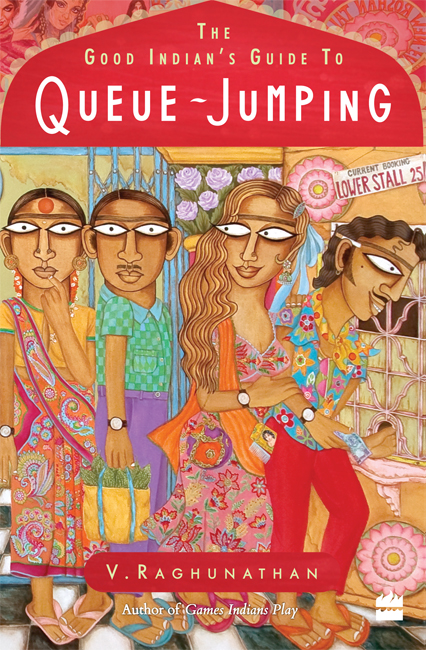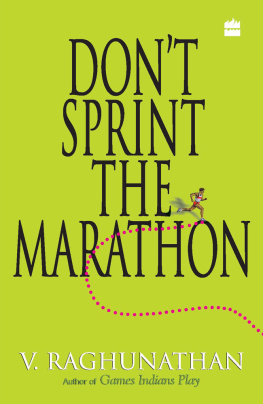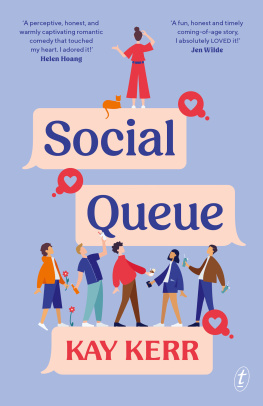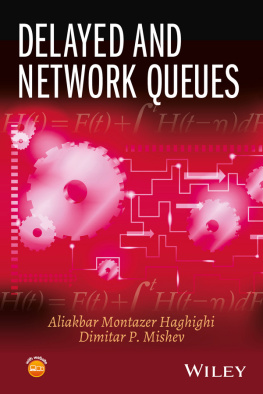Table of Contents

The Good Indians
Guide to
Queue-jumping
V. RAGHUNATHAN

HarperCollins Publishers India
To
The queue of my siblings (two ahead and two behind)
Uma, Rama, Shyama and Ravi
Contents

It was the day of the big sale. Rumours of the great deals (and some advertising in the local papers) were the main reason for the long line that formed in front of the store well before 8:30 a.m., the stores opening time.
A small man pushed his way to the front of the line, only to be pushed back amid loud and colourful curses. On the mans second attempt, he was punched square in the jaw, knocked around a bit and then thrown to the end of the line again.
As he got up the second time, he said to the person at the end of the line, That does it! If they hit me one more time, Im not opening the store!
I t is well known that the universe is not a place that is either constant or predictable. Quantum mechanics tells us it is not. It is not even orderly, if you go by the laws of thermodynamics, which tell us that the universe is tending towards maximum entropy, or headed towards maximal disorder. Well, if so, dont our fluid, fuzzy and often chaotic queues contribute more to the natural order of the universe? So why does the world often baulk at our frequent jumping of queues when it is patently clear that ours is a civilization closer to nirvana, for we, including our inherent reservations against queuing, flow with the forces of the universe?
A wise man is supposed to have said, Half of life is showing up. The other half is waiting in line. Cant disagree with that certainly not we who spend half our lives waiting in queues and the other half scheming how to jump them.
Those of us who lost our milk teeth in the 1960s and 70s may recall two-year-long queues for HMT watches and decade-long ones for a classic black rotary-dial phone, a Bajaj scooter or a Fiat car. And for basic justice from the courts, we have waited even longer and continue to do so.
My familiarity with queues has only increased with time. I recall a time in the 1980s when, come summer, I would be dispatched to the railway station for advance reservation of the familys journey from Punjab to Tamil Nadu. I would be armed with a dhurrie a heavy cotton rug an inflatable pillow and a mottled glass bottle (of Kissan Squash) of water, charged to sleep in the line in front of the railway reservation counters waiting for the gates to open, virtually making an event of it, with packed dinner and breakfast to boot. I recall this being the ritual for a US visa as well. Even the queues for gas cylinders and at shops were impressively long. And of course, much of my life has been spent witnessing or experiencing queues at railway stations; queues at municipal water taps; queues at bus stops; queues at taxi stands; queues outside cinema halls; queues at ration shops; queues at airports whether departure gates, airline counters, security gates or boarding gates; queues outside RTO offices; queues outside passport offices; queues at hospitals; queues outside restaurants; queues for voting; queues for admitting toddlers into nursery schools; queues at McDonalds; queues at toll gates on our newfangled highways in short, queues pretty much anywhere. The truth is, most of us, with the exception of most VVIPs and at one time the likes of Robert Vadra, are rarely far from a queue.
It may be that before the 1990s queues were largely driven by shortage on the supply side of goods and services while today they are mostly driven by excess of demand. But queues are, and almost always have been, a part of our lives as participants, as onlookers, and as sufferers.
Search for the Origin of Queues
When did queues first come into being as a social protocol? Did they exist in the primitive world? Where was the earliest known queue formed? Did they exist in ancient India? When did a queuing culture first take root in human society?
The last is a searching question even if, strictly speaking, an anthropological and not a sociological one. Be that as it may, I have spent some time hunting and gathering information on the Internet looking for the origins of queuing in the history of humanity. I was about to give up when I saw a news item emanating from our own continent, in an issue of the China Daily: Archaeological evidence suggests Chinese people once queued.
According to the report, archaeologists excavating near Yinxu the capital of the Shang Dynasty (1766-1050 BC) in the east of the country, about 500 kilometres from Beijing had made a most remarkable discovery: fossilized remains of three people, one behind the other, as if they were in a queue. Well, thats the oldest evidence I have been able to trace of Homo sapiens standing in queues, if this is evidence indeed. According to this report, Dr Charles Whitmore, a visiting palaeontologist with the Chinese Academy of Sciences, believed that the discovery had led to a paradigm shift in our understanding of the Chinese people. According to him, The scientific community has long believed Chinese people to be genetically unwilling to file singly (so we in India can take heart). But, following this discovery, he believed that this opinion about the Chinese unwillingness to queue up may have been wrong, given that once upon a time they did stand in line quite patiently. Dr Whitmore particularly rued the fact that even though thirty centuries ago the Chinese may have possessed the good sense to align one behind the other, today such linear formations are observed only in insufferably precise military exercises and firing squads!
But in China there are serious challengers to Whitmores finding. Since China is a communist country and a regulated society, the social attitudes there to queues differ from those in the West, where regulation stems from other roots. Thats why sceptics like Professor Shi-mian Maifu of Beijing Normal University refuse to rush into conclusions here. Shi-mian believes there could be other explanations for the linear alignment of the three ancestors: like a dance (retro-Bollywood?), or a practical joke, and urges Westerners to stand still and remain calm before rushing to declare their finding as if it were an anthropological milestone like the Java Man. Says Professor Shi-mian with some emphasis, I cannot believe that any reasonable, sane Chinese person would choose to purposefully increase the time he or she spends waiting out of deference to someone else. He refuses to stand behind that line of logic.
But either way both parties seem convinced that today the Chinese stand united in their dislike for forming queues, which provides us some consolation in our own country. So all those who believe that China and India cannot be spoken about in the same breath when it comes to wealth creation, infrastructure, manufacturing, exports, imports, infant mortality, or virtually any parameter of a countrys development, will have to reconcile themselves to the fact that the two countries do share a common antipathy to queues. One expatriate fumes in a blog thus: The Chinese solution [to queues] is to pretend that you are the only person in the room, and that you are the most important person in the world. You angle your elbows out and simply shove anyone in the way aside. Well, some may say ditto about us too.
However, our main concern here is the innate sociological attitude to queues in China. The reality in more recent times in that country is that you queue when you are







![Dębicki Krzysztof - Queues and Lévy Fluctuation Theory [recurso electrónico] $c](/uploads/posts/book/193156/thumbs/d-bicki-krzysztof-queues-and-l-vy-fluctuation.jpg)




